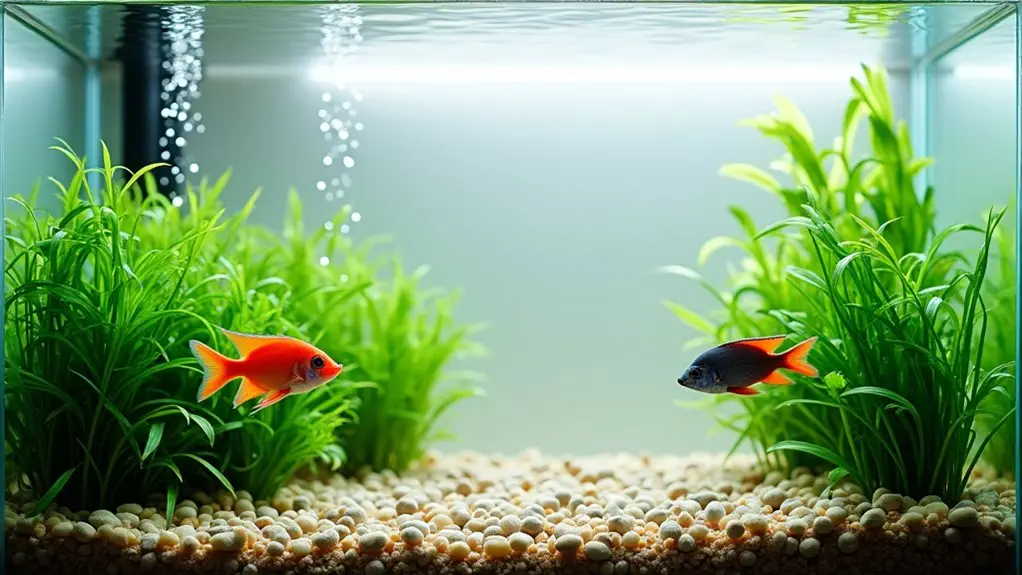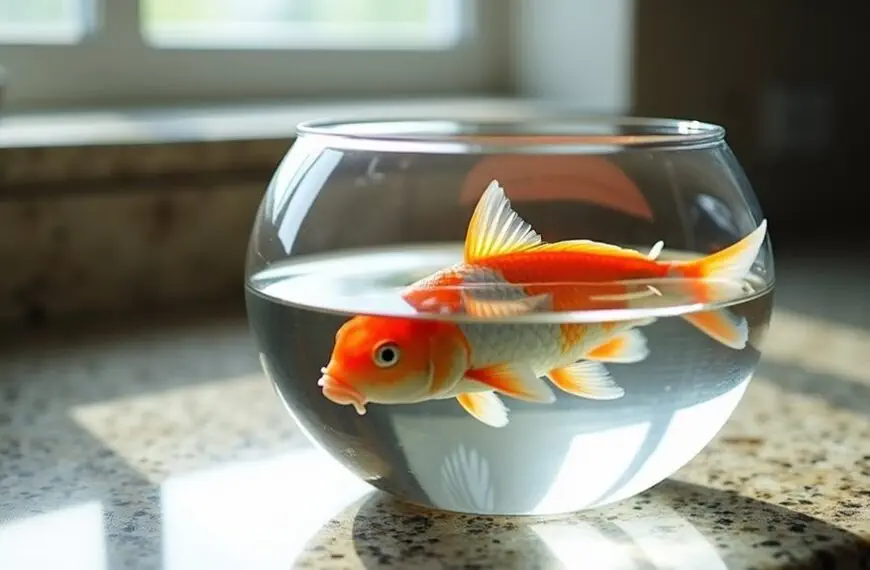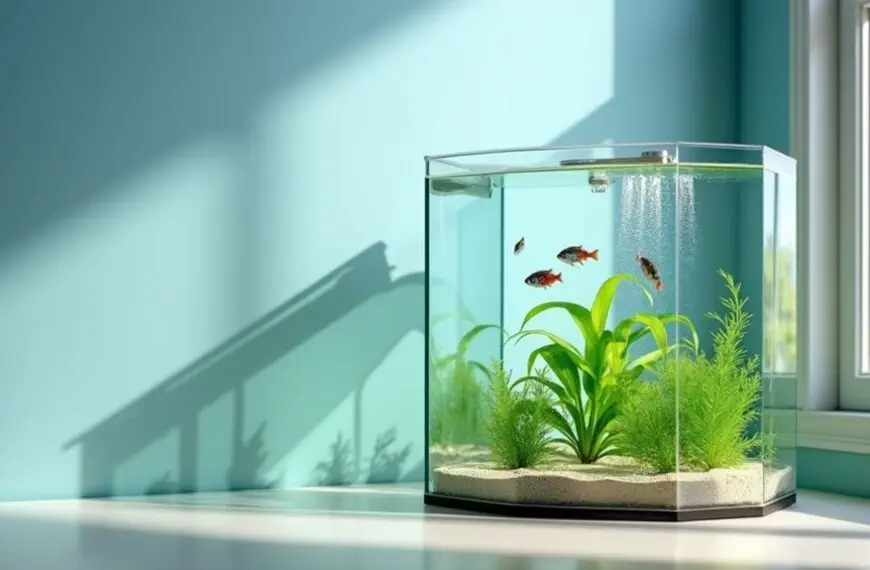To achieve crystal clear aquarium water, you'll need to focus on three key areas: proper filtration, regular maintenance, and bacterial balance. Start by installing quality mechanical and biological filters, replacing cartridges every 3-4 weeks. Perform weekly 10-20% water changes, and be sure to treat tap water with a dechlorinator before adding it to your tank. Don't overfeed your fish, as excess food leads to cloudiness, and test water parameters regularly to catch issues early. Keep your tank's lighting moderate to prevent algae growth, and consider adding live plants to help maintain water clarity. There's much more to maintaining pristine aquarium water than meets the eye.
Contents
- 1 Understanding Crystal Clear Water
- 2 Essential Filtration Components
- 3 Water Change Best Practices
- 4 Smart Feeding Guidelines
- 5 Chemical Water Treatment Methods
- 6 Bacterial Balance Management
- 7 Tank Setup Fundamentals
- 8 Equipment Maintenance Schedule
- 9 Common Water Clarity Problems
- 10 Frequently Asked Questions
- 10.1 Can LED Lighting Affect Water Clarity in My Aquarium?
- 10.2 How Do Different Substrate Colors Influence the Appearance of Water Clarity?
- 10.3 Does Using Reverse Osmosis Water Help Maintain Crystal Clear Aquarium Water?
- 10.4 Why Does My Aquarium Water Turn Cloudy After Adding New Decorations?
- 10.5 Can Certain Fish Species Contribute More to Maintaining Clear Aquarium Water?
- 11 Final Thoughts
Understanding Crystal Clear Water
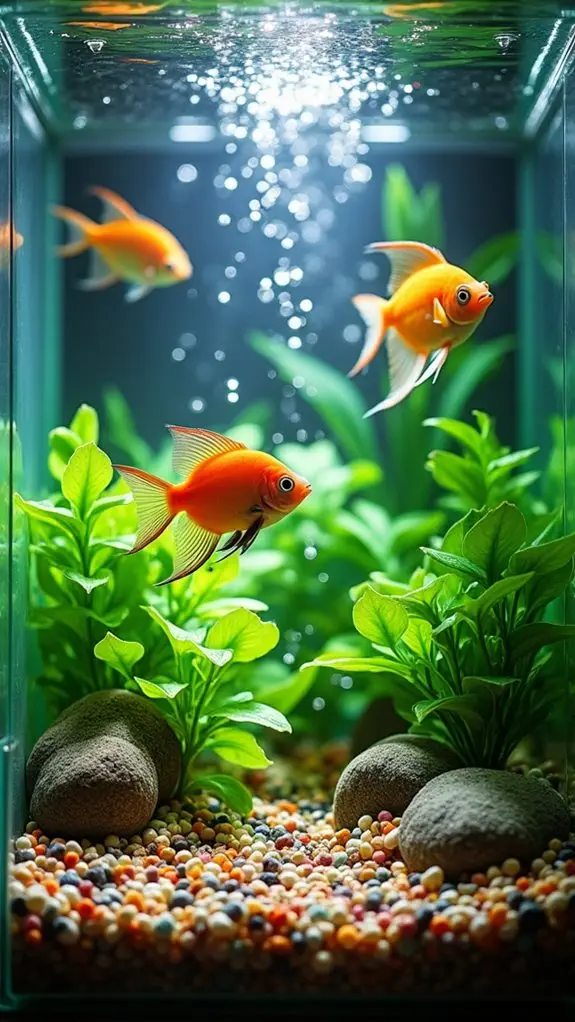
Nearly every aquarium owner dreams of crystal clear water, but achieving this requires understanding several key factors.
When you're aiming for pristine water clarity, you'll need to focus on creating the perfect environment for beneficial microorganisms while managing potential troublemakers like algae and waste products. Using reverse osmosis water provides the purest foundation for maintaining clarity long-term. Your fish will benefit greatly since clear water conditions allow them to direct more energy toward fighting off potential pathogens. Regularly testing water quality parameters ensures that any imbalances can be promptly corrected to support optimal clarity.
Your filter system plays a starring role in this aquatic ballet. You'll want to guarantee you have about 100 square feet of filter media surface area for each pound of fish, and your filter should be running for at least two months without cleaning to establish those vital bacterial colonies.
Don't forget about proper aeration – you'll need roughly 30 square inches of turbulent air/water interface per pound of fish.
What you feed your finned friends matters too. High-protein food (at least 45%) helps prevent those pesky dissolved organic compounds that can cloud your water.
Think of your aquarium as a miniature ecosystem where everything's connected. When you maintain proper filtration, feed quality food, and keep an eye on water parameters, you're setting the stage for that crystal-clear water you've been dreaming about.
Essential Filtration Components
Getting crystal clear water starts with understanding the three pillars of aquarium filtration: mechanical, biological, and chemical components.
Think of mechanical filters as your tank's first line of defense – they're like bouncers at a club, catching debris before it can cloud your water. Sponges, filter socks, and floss pads work together to trap floating particles and keep things tidy. Regular maintenance including filter cleaning every 3-4 months ensures optimal performance. Proper regular testing of water parameters also helps identify any potential disruptions in clarity.
Your biological filters are the real MVPs of your aquarium system. They're home to beneficial bacteria that break down harmful waste products through the nitrogen cycle. Regular cleaning helps prevent clogging and stagnation. Maintaining a stable temperature is also vital for these bacteria to thrive and maintain a healthy ecosystem.
Chemical filtration, while optional, can give your water that extra sparkle. Activated carbon works like a magnet for impurities, but remember to replace it monthly and remove it before adding fertilizers.
For the best results, you'll want to maintain your filters regularly and make sure they're properly sized for your tank. A well-balanced combination of all three filtration types will keep your aquarium looking crystal clear.
Water Change Best Practices
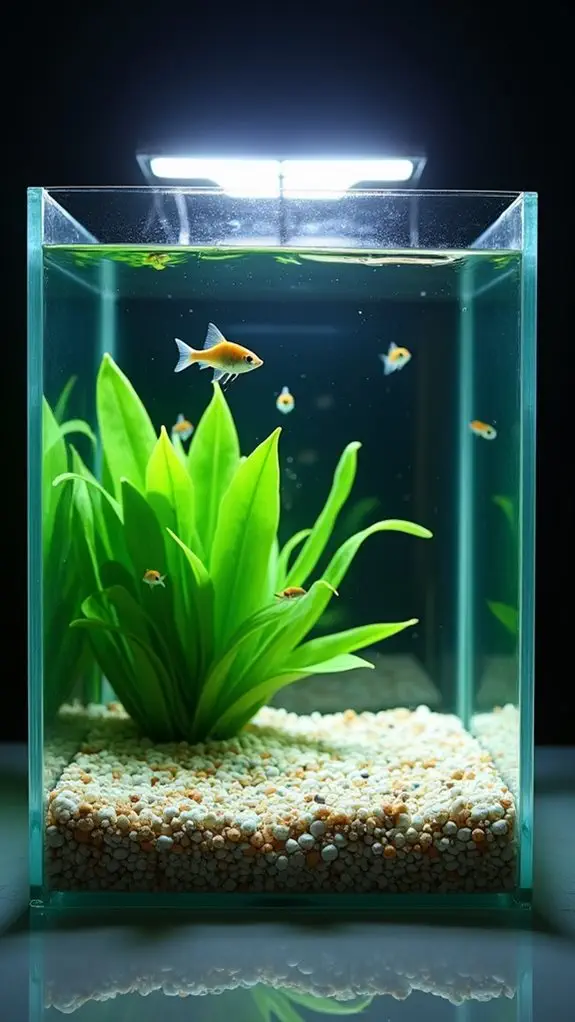
Regular water changes are the backbone of a crystal-clear aquarium. To keep your tank sparkling, you'll need to master both water change frequency and proper water change techniques. For most freshwater tanks, aim for 10-20% weekly changes, though you might need to bump this up to 30-50% if you've got a heavily stocked aquarium.
Modern pump systems can make water changes much more efficient and less time-consuming. When it's time to perform your water change, remember that slow and steady wins the race. You'll want to match the new water's temperature to your tank – think of it as making sure your fish don't get an unexpected cold shower! Always prepare your water 24 hours in advance to achieve the best parameters, as this helps in maintaining consistent water conditions.
Turn off your equipment, grab your siphon, and start by cleaning the glass and removing any dead plant matter. Don't forget to treat your new water with a dechlorinator before adding it back to the tank.
Keep an eye on those nitrate levels – they should stay below 80 ppm. If you're setting up a new tank, you'll need to be extra diligent with water changes, performing them 2-3 times per week until everything's stable.
Trust me, your fish will thank you for the fresh, clean water!
Smart Feeding Guidelines
Three key elements define smart feeding in your aquarium: timing, quantity, and automation. When you're aiming for crystal-clear water, proper feeding practices make all the difference, and today's smart technology can help you nail it every time. Overfeeding leads to excess nutrients that cloud your water.
Setting up automated feeding systems like JUWEL SmartFeed isn't just about convenience – it's about consistency. You'll want to program up to three feedings daily, following your fish species' specific needs. The beauty of customized schedules is that you can match them perfectly to your aquatic friends' natural feeding patterns. For optimal performance, testing portion sizes on a paper plate under the feeder helps determine the ideal amount for each feeding cycle. Maintaining water parameters, such as pH stability, is essential for your fish's health and can be affected by overfeeding.
Modern systems like Neptune Apex take things a step further by automatically shutting down equipment during feeding times. This smart feature prevents your skimmer from gobbling up food before your fish can get to it (we've all been there!).
You can even set up different modes for fish food versus coral feeding, ensuring everyone gets their proper nutrition without clouding up the water.
Don't forget about dosing systems for your coral additives and liquid supplements. They're like having a reliable assistant who never forgets to feed your tank's tiniest residents, keeping your water pristine and your aquatic family happy. Regular testing of water parameters helps ensure that these additives don't disrupt the delicate balance in your aquarium.
Chemical Water Treatment Methods
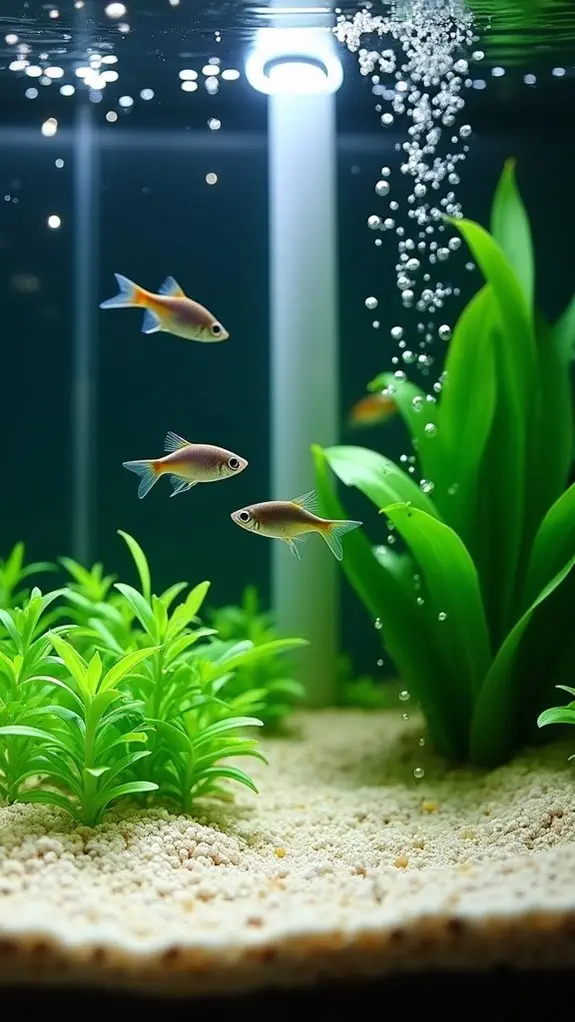
Chemical water treatments are often the first line of defense in maintaining crystal-clear aquarium water. Regular testing shows that tap water varies seasonally, making consistent treatment crucial for maintaining water quality. Understanding chemical neutralization techniques is essential for creating a healthy environment for your aquatic friends. Preventing bacterial blooms is critical when using chemical treatments to avoid cloudy water issues.
You'll want to start by treating tap water with the right products to remove harmful chlorine and chloramines, which can wreak havoc on your tank's ecosystem. Regular testing of water parameters, including ammonia levels, ensures the overall health of your aquarium inhabitants.
Here are the most effective chemical treatment methods you'll need:
- Use sodium thiosulfate at 5X the recommended dose to neutralize chlorine, especially if your city uses chlorine pulsing.
- Apply specialized products like Amquel to tackle stubborn chloramines.
- Install activated carbon filtration to remove impurities and unwanted odors.
- Add zeolite media to control ammonia levels naturally.
The activated carbon effectiveness in your filter will diminish over time, so you'll need to replace it every 4-6 weeks.
Don't forget to combine these chemical treatments with proper biological filtration – they work together like best friends at a party!
Just remember to follow dosage instructions carefully, as too much of a good thing can upset your tank's delicate balance.
Bacterial Balance Management
You'll need to balance your aquarium's bacterial population by promoting helpful biofilm growth while keeping harmful bacteria in check.
Getting this balance right means you're giving beneficial bacteria plenty of surface area to thrive on your filter media, while using tools like UV sterilizers to control any unwanted bacterial blooms that might cloud your water.
To keep everything running smoothly, you'll want to monitor your bacterial health through regular water testing and by watching for signs like cloudy water or unusual odors, which can tell you when it's time to take action. Additionally, ensuring that your tank is properly cycled to establish beneficial bacteria is crucial for maintaining clear water and a healthy ecosystem.
Supporting Beneficial Bacteria Growth
Maintaining a thriving colony of beneficial bacteria is the cornerstone of a crystal-clear aquarium.
To support your bacterial ecosystem, you'll need to create the perfect environment where these microscopic helpers can flourish and process beneficial nutrients effectively.
Here's what you can do to keep your beneficial bacteria happy and thriving:
- Feed your fish high-protein foods, which provide the right nutrients for bacterial growth.
- Perform regular 30% water changes while being careful not to over-clean.
- Maintain proper aeration with at least thirty square inches of turbulent surface per pound of fish.
- Avoid using antibiotics unless absolutely necessary, as they can harm beneficial bacteria.
- Ensure that ammonia levels remain between 2-5 ppm to support optimal bacterial development.
Controlling Harmful Bacterial Blooms
Bacterial blooms can transform your crystal-clear aquarium into a cloudy mess within hours. If you've ever experienced this milky haze, you're witnessing millions of heterotrophic bacteria multiplying every 15-20 minutes, turning your aquatic paradise into what looks like a glass of skim milk!
When it comes to bacterial bloom prevention, you'll want to focus on keeping excess nutrients in check. Start by performing regular 30% water changes weekly, and don't forget to remove any uneaten food or dead plants promptly. Your fish will thank you for not overfeeding them, as this common mistake often triggers blooms.
If you're already dealing with a bloom, don't panic – there are effective bloom treatment strategies at your disposal. First, boost your tank's aeration since these bacterial parties can seriously deplete oxygen levels. Remember that low oxygen levels can lead to hypoxia which poses a risk to your fish.
Next, perform a larger water change (30-50%) to flush out excess nutrients. Add some activated carbon to your filter, and consider introducing live plants to help stabilize your tank's ecosystem.
Monitoring Bacterial Health
Three key indicators reveal your aquarium's bacterial health: ammonia levels, nitrite readings, and water clarity. Regular bacterial testing and ammonia monitoring aren't just fancy terms – they're your early warning system for potential problems.
When your beneficial bacteria are thriving, you'll notice crystal-clear water and undetectable ammonia levels.
To maintain peak bacterial health, follow these essential steps:
- Test your water parameters twice weekly, focusing on ammonia and nitrite levels.
- Clean your filter media using tank water only, preserving those hardworking beneficial bacteria.
- Monitor water clarity daily – cloudy water often signals a bacterial imbalance.
- Keep feeding in check to prevent overwhelming your biological filtration.
You'll want to pay special attention to your tank after any major changes, like adding new fish or deep cleaning your filter.
If you notice ammonia or nitrite readings above zero, it's time to take action. Consider adding bacterial supplements to boost your biological filtration, and don't forget that regular maintenance is your best friend. Maintaining optimal water quality is critical for sustaining beneficial bacteria and avoiding toxic spikes that can harm your fish.
Tank Setup Fundamentals
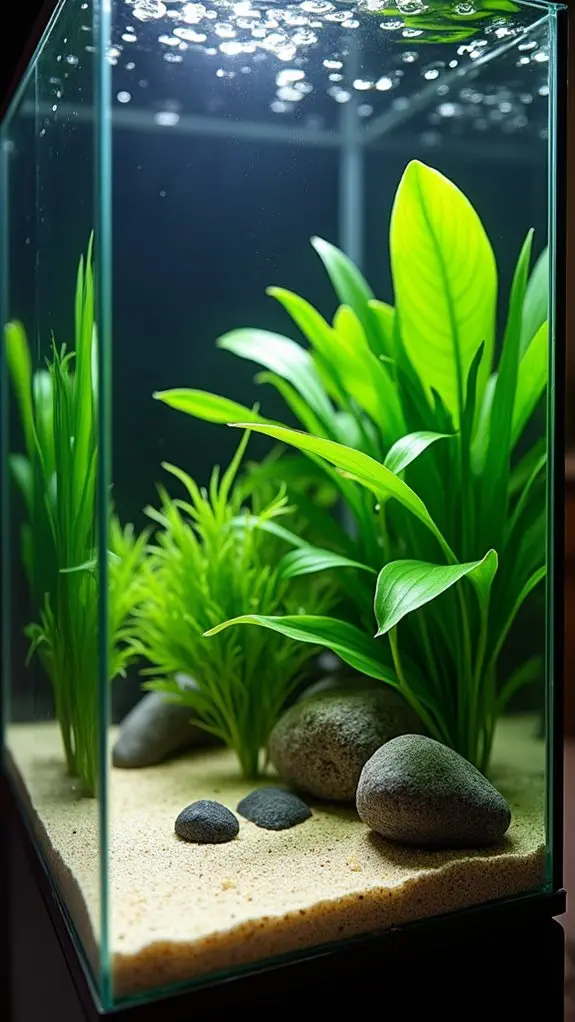
Proper tank setup forms the foundation for achieving and maintaining crystal-clear aquarium water.
When it comes to tank placement, you'll want to avoid areas with direct sunlight and stay clear of air conditioning vents, as these can cause algae growth and temperature fluctuations that cloud your water. Choose a stable, level surface near electrical outlets and a water source to make maintenance easier.
Your substrate selection plays an essential role in water clarity. Before adding it to your tank, you'll need to rinse it thoroughly until the water runs clear. Pour in about 2-3 inches of substrate, especially if you're planning to add live plants.
Next, you'll want to position your equipment and decorations, but don't turn anything on just yet.
Once you've got the basics in place, it's time to add dechlorinated water and start the cycling process. Consider adding beneficial bacteria to jumpstart the cycle, and don't forget to install activated carbon in your filter – it's like a magnet for unwanted particles that can cloud your water. Additionally, monitoring water parameters during the cycling process is crucial to ensure a healthy environment for your fish.
Regular maintenance, including water changes and filter cleaning, will help maintain that crystal-clear appearance you're aiming for.
Equipment Maintenance Schedule
With your tank setup complete, following a regular equipment maintenance schedule will keep your aquarium water sparkling clear. Your filter efficiency plays a vital role in maintaining crystal-clear water, so you'll want to check it weekly and clean it according to the manufacturer's guidelines.
While equipment upgrades can improve your setup, proper maintenance of your existing gear is often all you need.
Here's your essential maintenance checklist to follow:
- Perform weekly water tests to monitor ammonia, nitrites, and nitrates, adjusting chemistry as needed.
- Clean pre-filter media weekly and replace filter cartridges every 3-4 weeks.
- Check all equipment functionality, including heaters and pumps, during weekly water changes.
- Clean air stones monthly and inspect tubing for potential leaks or blockages.
Remember to keep a maintenance log to track when you've completed these tasks. It's much easier to maintain clear water than to fix cloudy conditions later.
If you notice any decrease in water clarity, don't wait – address it immediately by checking your filter and performing necessary maintenance. Think of it like keeping your car running smoothly – regular tune-ups prevent bigger problems down the road.
Common Water Clarity Problems
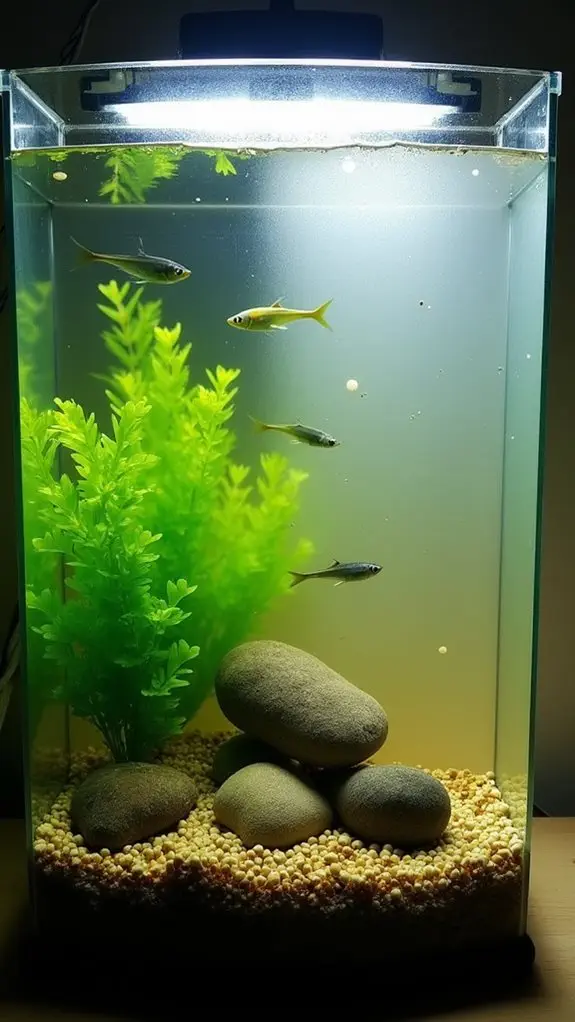
If you're seeing cloudy water in your aquarium, you're likely dealing with one of two common culprits: excess waste particles or a sudden algae bloom.
When waste from overfeeding and fish activity builds up, it can create a milky haze that won't clear on its own, while green water typically points to an algae issue caused by too much light and nutrients.
Understanding these differences is key to choosing the right solution, whether it's improving your filtration for cloudy water or adjusting light exposure and nutrients for that pesky green tint.
Cloudy Water Causes
Aquarium enthusiasts often face cloudy water, one of the most frustrating challenges in fishkeeping. Understanding the main cloudy water sources and water clarity factors can help you tackle this common issue effectively.
You'll find that most cloudiness stems from four primary causes:
- Particulate Matter: Stirred-up substrate, new sand, or floating debris that hasn't been filtered out yet.
- Bacterial Blooms: Microscopic bacteria multiplying rapidly, often due to excess ammonia from overfeeding or overstocking.
- Organic Waste: Decomposing food, fish waste, and plant matter that's accumulated in your tank.
- Mineral Deposits: Hard water issues, high iron content, or dissolved minerals affecting water clarity.
If you've recently set up your tank, don't panic! That milky haze is probably just a bacterial bloom, which is actually a good sign that your biological filtration is establishing itself.
However, if you're dealing with cloudy water in an established tank, you'll want to check your maintenance routine. Overfeeding is often the sneaky culprit – those extra food particles breaking down can turn your crystal-clear water into a cloudy mess faster than you'd think.
Green Water Solutions
While cloudy water can be frustrating, green water presents its own set of challenges for fish keepers. When your aquarium looks like pea soup, you're dealing with suspended algae that's having a field day in your tank.
Effective algae management starts with understanding what's causing the problem, whether it's excess light, overfeeding, or poor filtration.
You've got several weapons in your arsenal for nutrient control and algae elimination. Installing a UV filter can zap those pesky algae cells, while adding live plants helps compete for nutrients that algae would otherwise use.
If you're looking for immediate results, algaecides can quickly clear the water, but don't forget to address the root cause.
Prevention is your best friend here. Keep your tank away from direct sunlight, stick to a regular maintenance schedule, and don't overfeed your fish (they'll thank you for it!).
Remember to check your filtration system regularly – it's like your tank's personal bouncer, keeping unwanted guests out. By maintaining proper water parameters and using tools like activated carbon or phosphate removers, you'll be well on your way to crystal-clear water.
Frequently Asked Questions
Can LED Lighting Affect Water Clarity in My Aquarium?
Yes, your LED lighting can affect water clarity. By choosing the right LED spectrum and adjusting lighting intensity, you'll control algae growth and promote healthy plant development, which helps maintain clearer water in your aquarium.
How Do Different Substrate Colors Influence the Appearance of Water Clarity?
Your dark substrate creates less color contrast with the water, making it appear clearer, while light substrates highlight particles and reflections. Substrate texture also plays a role in how you'll perceive water clarity.
Does Using Reverse Osmosis Water Help Maintain Crystal Clear Aquarium Water?
Yes, you'll notice significant benefits from reverse osmosis water purification techniques. It removes contaminants and dissolved solids that can make water cloudy, helping you maintain crystal-clear conditions in your aquarium long-term.
Why Does My Aquarium Water Turn Cloudy After Adding New Decorations?
Your aquarium's cloudy water after adding new decorations is likely due to stirred-up substrate, unwashed decorations releasing particles, or a bacterial bloom. You'll need to rinse items thoroughly before introducing them next time.
Can Certain Fish Species Contribute More to Maintaining Clear Aquarium Water?
Yes, you'll find that certain fish like Siamese algae eaters and plecos help maintain clarity through algae control. When choosing tank mates, consider fish compatibility to prevent overcrowding and excess waste production.
Final Thoughts
You're now equipped with all the tools you'll need for crystal-clear aquarium water. Remember, it's not just about one solution but a combination of proper filtration, regular maintenance, smart feeding, and maintaining that essential bacterial balance. By following these guidelines consistently, you'll transform your cloudy tank into a stunning underwater showcase that'll make both you and your fish happier. Keep at it – your aquarium's clarity is worth every effort!

